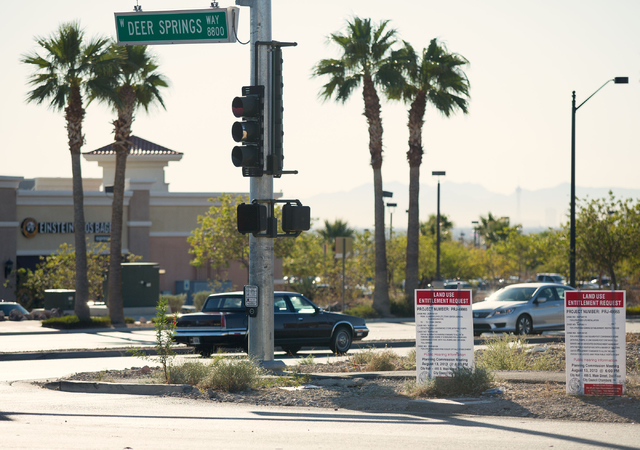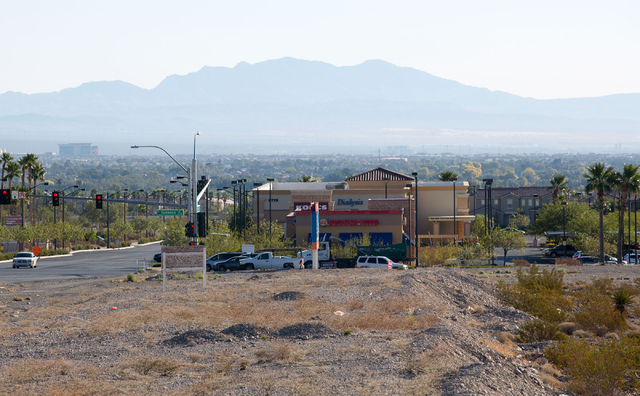Suburbs struggle with urban lifestyle
Las Vegas has embraced a higher-density urban lifestyle, if the hundreds of millions of dollars flowing to revitalizing downtown Las Vegas is any measure.
But efforts to export the concept to the suburban fringe, even where the population is relatively dense, aren’t working as well.
The clearest example is the Town Center area in northwest Las Vegas. Developers recently won a major modification to add a suburban staple, the gas station/convenience store/car wash, on land where city planners had called for a more urban multistory development.
The decision was hard-fought, with the City Council splitting 4-3 on approving the proposal despite opposition from Councilman Steve Ross who represents the area. That was a deviation from the usual deference shown to council members on issues limited to their wards.
The development group, which includes property owner James Marsh; gas station and convenience store operator Raymond Shapiro; and investor Anthony Marnell III, can now build at Deer Springs Way and Durango Drive without meeting certain land use requirements calling for short setbacks and other urban-style features.
“The timing is right; the use is appropriate. We would not be involved in this if this was not going to be a very high-quality, well-run operation,” said Marnell, who founded M Resort.
He is the son of Tony Marnell, whose casino development credits include Caesars Palace, Wynn Las Vegas and the Rio.
For opponents it meant a potentially fatal blow to an effort to encourage more tall buildings and sidewalk retail in the northwest corner of the city, where more retail and office space could provide more jobs close to tens of thousands of residential rooftops.
“It is a sprawl complex with the convenience store pushed way back and the gas pumps out front,” Ross said. “My vision and the city’s vision and the city planners’ vision for that area on Durango was something bigger and better.”
To build the way they wanted, developers needed the council to approve the major modification to a 3.96-acre property. The modification switched the land use category from Urban Center Mixed Use to General Commercial Town Center.
The Urban Center category includes “build-to-line” front setbacks and allows buildings up to 12 stories. Planners think it encourages more imaginative, mixed use projects.
The General Commercial Town Center designation limits building heights to two stories, and requires 15-foot setbacks.
That is standard fare in suburbs, and much like the land use around the Town Center Plan site.
Adopted in 2001, the Town Center Plan covers about 2,000 acres in the northwest, planning director Flinn Fagg said.
The idea was to offer a concentration of jobs, homes and shopping for people who prefer short commutes or walking.
Fagg cited Santana Row in San Jose and Denver’s Stapleton neighborhood as successes in creating an urban feeling in a suburban community. A Las Vegas example is Town Square on the south end of the Strip.
“Many people go to Town Square just because they like the feeling of being there, being able to walk and window shop and go to restaurants,” he said.
Yet in the decade since the Town Center plan was adopted there has been little interest in urban-style construction there.
One nearby midrise office building remains vacant, while parcels covered by the Urban Center requirements remain undeveloped, even as more suburban style projects have developed around them.
The modification for the gas station proposal covers less than four acres, but it creates an exception in the heart of an area planned as an “urban zone.” Another 600 acres in the area remains undeveloped, Fagg said, although 200 are spoken for through entitlements.
While there has been some urban-style building in the area, it hasn’t developed as planners envisioned.
The lack of developer interest in urban projects and support from nearby residents who signed petitions and attended the meeting to ask the council to approve the gas station and convenience store project prompted the council to override Ross’ desire to stay the course.
“This plan stinks. That is the problem,” Councilman Bob Beers said. “Across the street another plan worked, and people built.”
Contact Benjamin Spillman at bspillman@reviewjournal.com and follow him on Twitter at @BenSpillman702.















